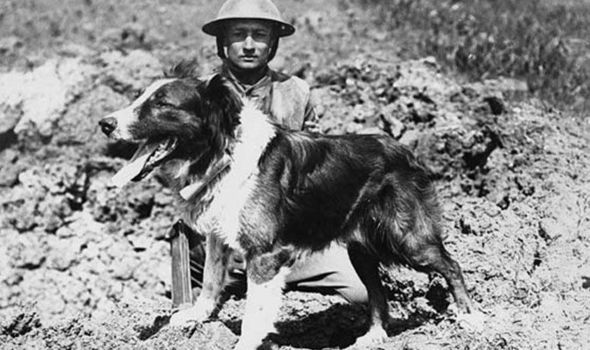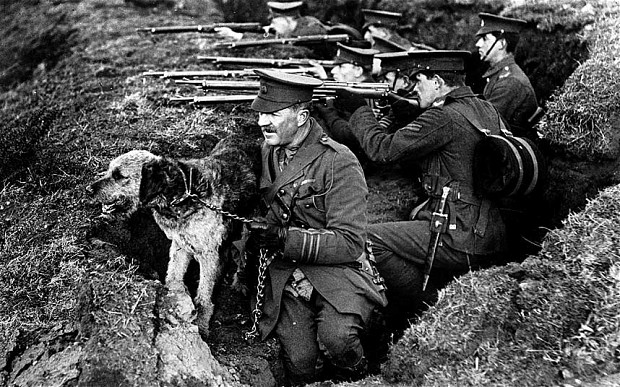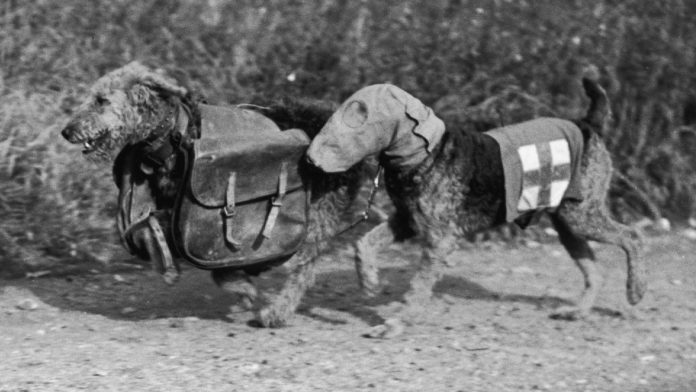Dogtrophy.com celebrates the life of Jack – an Airedale Terrier trained at the British War Dog School during WWI. Established in 1917 by Lieutenant Colonel Edwin Richardson, the school trained dogs to serve in the trenches.
Shaggy black and beige, with drooping ears and matted fur, Jack the Airedale does not meet the average image of the WWI hero. But in 1918, while serving on the Western Front with the Sherwood Foresters, he dropped his snout to the muddy floor and went on a charge which resulted in an entire battalion being saved.
In 1918, a detachment of the Foresters were at an advanced post, surrounded by the German Army, all communications cut off and with the supply lines four miles behind them. Their only hope rested on Jack’s fragile shoulders. A message requesting urgent help was tied to his collar, and he was dispatched to try and make it to headquarters.

The Great War messenger dogs were taught to seek out cover amid the carnage of No Man’s Land. As Jack darted between craters, he was struck twice by German bullets. He made it, but only at a crawl, covered in blood and died of his injuries on arrival. The message, however, got through.
Jack was one of some 20,000 dogs to serve on the Western Front, like many, he was recruited from London’s Battersea Dogs Home. Despite his heroism, he never received a medal.
Lieutenant Colonel E.H Richardson, a police and military dog trainer, first wrote to the home in 1914 to request a batch of recruits for a specialist canine brigade training centre that he wished to establish in Shoeburyness, Kent. The home, which was established in 1860, had already received an influx of dogs following the outbreak of war as people struggled to feed themselves, let alone their dogs.
Some desperate owners slipped off their dog’s collars and bought them to Battersea on a piece of string to pretend they were strays. One account tells of a woman breaking down in tears after her pet tried to follow her out of the home as she left.
Lt Col Richardson was after lurchers, known as the poacher’s dog and perfectly suited to war, as well as airedales, collies, sheepdogs and whippets. By 1915 his training centre was up and running.
Each dog was required to undergo six weeks of intensive training, leaping over obstacle courses, shell holes and through torn barbed wire. Initially, Richardson planned for his dogs only to search out injured soldiers on the battlefield, but it soon became apparent they made excellent messengers as well.

“The skill, courage and tenacity of these dogs has been amazing,” he said. “During heavy barrages, when all other communications have been cut, the messenger dogs have made their way, and in many cases have brought messages of vital importance.”
Great danes, boarhounds and mastiffs were also considered ideal watchdogs. The animals were posted on sentry duty near the top of the trench, next to its master’s gun barrel, to let the soldier know quietly if anyone attempted to approach.
A report, from a newspaper in 1916, describes the temperament required from such an animal. “A watchdog never barks; at the most he will use a low growl to indicate the presence or approach of a hostile force. More often than not the mere pricking of the ears or the attitude of expectancy is sufficient to put his master on his guard.”
Such was the danger of their posting that many of the animals were killed. The Dundee Courier, in November 1916, detailed the fate of Marquis, a dispatch dog with the French army. “His soldier comrades buried him and raised a monument over his grave. He had been sent out with a message at a time when owing to the intensity of German fire, it was unsafe to send a human messenger. Marquis received a bullet wound and fell, but managed to crawl back with the message undelivered, letting it drop out of his mouth, stained with blood at his masters feet”.





